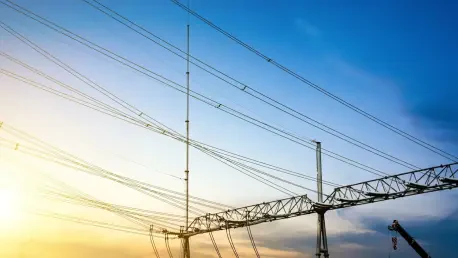As an intense heatwave engulfs the eastern half of the United States, electricity prices across regional grids have surged dramatically, escalating concerns about the resiliency of the nation’s energy infrastructure. With temperatures skyrocketing beyond 100 degrees Fahrenheit, power transmission systems and natural gas-fired plants have been pushed to their limits. In New York City, wholesale electricity prices reached about $2,400 per MWh during peak evening demand, while Long Island saw prices soar above $7,000 per MWh. These astronomical price spikes underscore the stress placed on the electrical infrastructure and highlight the urgent challenges facing operators in stabilizing the grid while dealing with climate-induced extremes. As grid operators scramble to balance supply and demand, insights emerge about the current state of U.S. power grids, their vulnerabilities, and the imperative for strategic improvements to ensure a resilient future.
The Strain on Infrastructure
Transmission Lines and Power Plants Under Pressure
The profound surge in electricity prices has ignited a multifaceted response from grid operators like PJM Interconnection, the largest U.S. power grid operator, which, pushed to the brink, directed utilities towards voluntary reductions in customer electricity consumption. This scenario of escalating prices and operational strains paints a vivid picture of a system on the verge of overload. The provision of electricity is straining under current conditions, illuminating the challenges inherent in maintaining operational stability. Further, with volatile weather patterns forecasted to continue, the geographical vulnerability of certain power plants further compounds the crisis.
In the battle to keep the lights on, many regions such as New England and the Southeast are grappling with significant challenges to maintaining reliability. The necessity to preserve grid stability amidst unparalleled pressures has prompted the implementation of emergency interventions tailored to fortifying the existing infrastructure. These measures include enhancing reserve resources, importing electricity from adjacent regions, and delaying non-essential maintenance operations. Yet, this matrix of responses underscores a profound question: Are emergency measures such as load curtailments and ramping up standby units sufficient to ensure stability in the face of such unprecedented demand surges?
Operational Adjustments and Emergency Strategies
Amidst soaring demand, grid operators have called for innovative approaches to circumvent severe outages and ensure continuity of electricity supply. Coordinated efforts by grid authorities, including ISO New England and the U.S. Department of Energy, have led operators to issue directives to augment electricity supplies hastily. These strategies include tapping into standby units and leveraging assistance from neighboring regions during pressing needs. By implementing rapid operational adjustments, grid operators are mitigating the immediate risk of widespread outages. Nevertheless, the broader picture remains one of substantial systemic vulnerability, compelling a reevaluation of current strategies and the introduction of substantive reforms.
Critical to this discourse is the acknowledgment of the limitations in existing infrastructure when confronted with climate-induced challenges of this magnitude. As emergency strategies unfold, the question persists: How can grid systems be feasibly redesigned to withstand increasing environmental pressures while meeting future energy demands? The focus on innovation and strategic foresight becomes essential in shaping systems that are resilient to not only present threats but also foreseeable climate impacts on operational infrastructure.
Challenges in Balancing Supply and Demand
Power Supply Shortages and Preventative Measures
Efforts to counterbalance the extraordinary demand during this heatwave have illuminated the scarcity in power supplies and the subsequent preventive measures adopted to preclude large-scale disruptions. Load curtailment strategies have become a crucial tool in managing electricity flow, ensuring that the available power is judiciously distributed to avert outages. The challenges of harmonizing supply with surging demand highlight an exigent issue: the need for a diversified energy supply mechanism that is less susceptible to disruptions. Moving forward, the role of renewable energy emerges as a pivotal factor in fortifying the resilience of power grids.
By integrating renewable energy sources, grid reliability can be substantially improved. However, maximizing the role of renewables necessitates enhanced technologies to store and distribute energy effectively. The intricate process of transitioning from fossil-fuel dependency to renewable sources will, therefore, necessitate not only infrastructural investments but also policy reforms that facilitate smooth integration. This transition period, characterized by strategic foresight and adaptive policies, will be invaluable in forging a sustainable solution amidst unfolding climate scenarios.
The Vulnerability of U.S. Power Grids
This intense period of grappling with escalating electricity prices and demand surges shows the acute vulnerabilities within U.S. power grids when confronted with adverse weather. It highlights the fundamental need for bolstering infrastructure resilience and implementing proficient contingency planning. The current crisis has illuminated structural deficiencies, serving as a catalyst for industry stakeholders to engage in dialogue and action addressing these crucial challenges. By focusing resources on modernizing grids and optimizing regulatory frameworks, a foundation for a more resilient and adaptive power system can be established.
The conversation around grid reform and modernization must encompass the collective expertise of industry stakeholders, policymakers, and technological innovators. Future-proofing the electricity network will require transparent, proactive collaborations and investment strategies aimed at enhancing the robustness of the nation’s energy infrastructure. As the nation navigates the dynamic evolution of its power systems, ensuring adaptability to environmental fluctuations will determine future wellness and reliability of electricity provision.
A Call for Strategic Energy Reforms
The dramatic rise in electricity prices has spurred a complex response from grid operators like PJM Interconnection, the largest power grid operator in the U.S. Faced with this crisis, they have guided utilities to voluntarily reduce customer electricity consumption to prevent overload. This scenario of rising prices and operational challenges highlights the fragility of the current electricity provision system. The struggle to maintain operational stability is stark, especially with unpredictable weather patterns likely to persist, adding to the peril due to certain power plants’ geographic vulnerabilities.
Regional areas such as New England and the Southeast are experiencing significant hurdles in maintaining grid reliability. In response to these pressures, emergency measures are being taken to strengthen the grid. These include increasing reserve resources, importing electricity from nearby regions, and postponing non-essential maintenance. Despite these efforts, a crucial question remains: Are emergency tactics, like load reduction and activating standby units, enough to ensure grid stability amidst such overwhelming demand surges?









